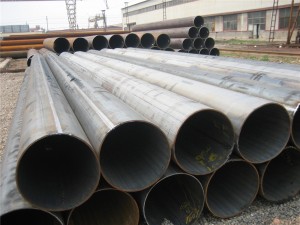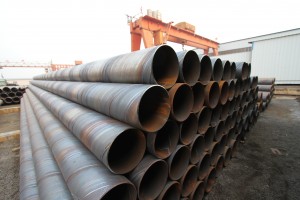Spiral Steel Pipe and LSAW Steel Pipe are two common types of welded steel pipe, and there are some differences in their manufacturing process, structural characteristics, performance and application.
Manufacturing process
1. SSAW pipe:
It is made by rolling strip steel or steel plate into a pipe according to a certain spiral angle and then welded.
The weld seam is spiral, divided into two kinds of welding methods: double-sided submerged arc welding and high-frequency welding.
Manufacturing process can be adjusted strip width and helix angle, to facilitate the production of larger diameter steel pipe.
2. LSAW pipe:
The strip steel or steel plate is directly bent into a tube and then welded along the longitudinal direction of the tube.
The weld is distributed in a straight line along the longitudinal direction of the pipe body, usually using high-frequency resistance welding or submerged arc welding.

The manufacturing process is relatively simple, but the diameter is limited by the width of the raw material.
So the pressure-bearing capacity of LSAW steel pipe is relatively weak, while spiral steel pipe has stronger pressure-bearing capacity.
Specifications
1. Spiral Steel Pipe:
It is suitable for the production of large-caliber, thick-walled steel pipe.
The diameter range is usually between 219mm-3620mm, and the wall thickness range is 5mm-26mm.
can utilize narrower strip steel to produce wider diameter pipe.
2. LSAW steel pipe:
Suitable for the production of small diameter, medium thin-walled steel pipe.
The diameter range is usually between 15mm-1500mm, and the wall thickness range is 1mm-30mm.
The product specification of LSAW steel pipe is generally small diameter, while the product specification of spiral steel pipe is mostly large diameter. This is mainly because the production process of LSAW steel pipe determines its relatively small caliber range, while the spiral steel pipe can be adjusted through the spiral welding parameters to manufacture different specifications of the product. Therefore, spiral steel pipe is more advantageous when large diameter steel pipe is required, such as in the field of water conservancy engineering.
Strength and stability
1. Spiral steel pipe:
The welded seams are helically distributed, which can disperse the stress in the axial direction of the pipeline, and therefore have stronger resistance to external pressure and deformation.
The performance is more stable under various stress conditions, which is suitable for long-distance transportation projects. 2.
2. Straight seam steel pipe:
Welded seams are concentrated in a straight line, the stress distribution is not as uniform as spiral steel pipe.
Bending resistance and overall strength is relatively low, but because of the short welding seam, the welding quality is easier to ensure.
Cost
1. Spiral steel pipe:
Complicated process, long welding seam, high welding and testing cost.
Suitable for the production of large diameter pipes, especially in the case of insufficient width of the strip steel raw material is more economical. 2.
2. LSAW steel pipe:
Simple process, high production efficiency, short weld seam and easy to detect, lower manufacturing cost.
Suitable for mass production of small diameter steel pipe.
Weld seam shape
The weld seam of LSAW steel pipe is straight, while the weld seam of spiral steel pipe is spiral.
The straight weld seam of LSAW steel pipe makes its fluid resistance smaller, which is favorable for fluid transportation, but at the same time, it may also lead to stress concentration at the weld seam, which affects the overall performance. The spiral weld seam of spiral steel pipe has better sealing performance, which can effectively prevent the leakage of liquid, gas and other media.
Post time: Jun-18-2025







